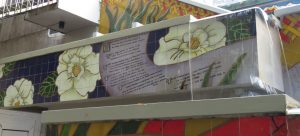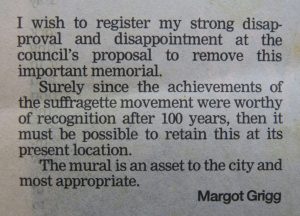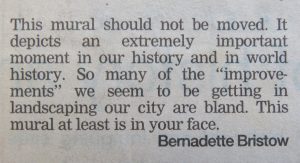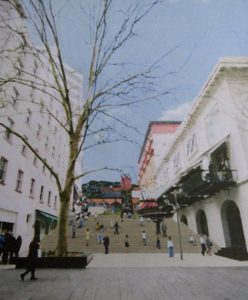International Women’s Day: A Visit to the Auckland Suffrage Memorial
On International Women’s Day which celebrates women’s achievements globally, we visit the Auckland Suffrage Memorial in Te Hā o Hine Place
Written by Cathy Casey and Megan Hutching
Standing in Te Hā o Hine Place, (formerly Khartoum Place) looking at the steps going up to Kitchener Street and the Art Gallery, the colourful tiles on the walls make the space glow. But few people know the story behind the mural and the women represented there and even fewer know of the 30-year battle to keep it there.
From a distance, you will see a row of women. Your eye may follow the ribbon with writing on it cascading down, weaving past Rangitoto, white camellias and a pohutukawa tree. What can it be? The answer lies in the wreath-surrounded panel which says ‘Women’s Suffrage Centenary 1893-1993’.
 [Image: Cathy Casey)
[Image: Cathy Casey)
Suffrage sounds painful, but it just means the right to vote in political elections. In 1893, Aotearoa New Zealand was the first country in the world to give women this fundamental human right. In 1993, we marked the 100th anniversary of women’s suffrage all over the country. There were books written, talks given and celebratory events. Many memorials were built, including the Auckland Suffrage Memorial. It was wonderful for New Zealand to finally celebrate women’s achievements through public art.
The Suffrage Memorial was designed and made by two local artists, Jan Morrison and Claudia Pond Eyley. It was a tough commission. They had to encapsulate the campaigns for the vote in a difficult space that had not only steps but a water feature over four levels.
 Artists Jan Morrison (left) and Claudia Pond Eyley [Image: Cathy Casey)
Artists Jan Morrison (left) and Claudia Pond Eyley [Image: Cathy Casey)
The artists decided on a combination of images to reflect the national as well as the local campaigns in Tāmaki and Te Taitokerau.
The national campaign is reflected in the wide white ribbon looping down through the four levels of the memorial which represents the suffrage petition of 1893 asking for the right to vote. It was signed by over 30,000 women. On the memorial you can see the signatures of some of the Auckland women who signed it.
While many people have heard of Kate Sheppard when it comes to the struggle to get women the vote, the artists wanted to celebrate the women who were involved in the campaigns in Auckland and Northland. The women standing so staunchly in a row at the bottom of the stairs include Amey Daldy, Lizzie Rattray, Annie Schnackenberg and Matilda Allsop. And yes, those are their actual faces.

Standing women (left to right): Amey Daldy, Anne Ward, Lizzie Rattray, Matilda Allsop, Elizabeth Yates, Annie Schnackenberg, Fannie Brown and two unknown suffragists [Image: Cathy Casey)

Memorial Plaque [Image: Cathy Casey)

 [Image: Cathy Casey)
[Image: Cathy Casey)
The Bill passed in parliament in 1893 and was signed by the Governor, making it law, on 19 September 1893. We now celebrate on this day every year and there is always an event at the memorial in Te Hā o Hine Place at lunchtime. Go along, and wear a white camellia.
The memorial was opened on Monday 20 September 1993. There was a large meeting at the Auckland Town Hall, with many women dressed in 1893 costume, then a procession through the streets to the memorial. When the then Governor-General, Dame Catherine Tizard cut the ribbon, the covering fell away and the memorial was revealed in all its glory. It was a great celebration both of the campaigning women of 1893 and the creativity of the artists, Jan Morrison and Claudia Pond Eyley.

Governor-General Dame Catherine Tizard cutting the ribbon on the Auckland Suffrage Memorial, 20 September 1993 [Image: Jan Morrison]
In the years following, there was a concerted effort from some quarters to remove the memorial to make access to the Art Gallery easier. Things came to a head in 2005, when Auckland City Council decided to allocate $2 million for the upgrade of Khartoum Place to coincide with the completion of the $90 million redevelopment of the Auckland Art Gallery. A design competition attracted 25 entries. None of the 12 finalists’ designs retained the memorial. The winning designers – chosen by an independent panel – produced three options, two of which required the demolition of the memorial, one requiring its relocation. When the council advised the artists of its plans for the memorial in a face to face meeting, they were outraged, even more so when council staff took them to visit alternative sites where the memorial could be relocated.
As soon as the meeting ended, Jan Morrison kicked off what was to become a long campaign to save the memorial in situ by enlisting the help of New Zealand Herald journalist Brian Rudman.
The arts fraternity – headed by gallery owner Gary Langsford and art critic Hamish Keith – took an immediate and very public stand in the media criticising the artistic value of the memorial and calling for its removal and replacing with. Gary Langsford told the New Zealand herald that ‘the tiles have no aesthetic merit and belong in a 1970s craft shop”. In response, Brian Rudman wrote scathingly:
“The Grand Poohbahs of Auckland just can’t help themselves when it comes to the Khartoum Place suffrage memorial. To them it’s folk art excrescence, polluting the front door of their newly upgraded temple of high art.”
Over many weeks Rudman wrote a number of hard-hitting columns supporting the memorial’s retention in Khartoum Place and asking the council to acknowledge the memorial’s historical value.
In response, some of New Zealand’s most powerful women stepped up to support keeping the memorial where it is, including the then-Women’s Affairs Minister Lianne Dalziell, Dame Catherine Tizard who had opened the memorial, Dame Georgina Kirby, Dame Dorothy Winstone and Dame Thea Muldoon.

Left to right: Dame Catherine Tizard, Dame Georgina Kirby, Lianne Dalziel, Dame Dorothy Winstone and Dame Thea Muldoon [Image: Sunday Star-Times 2 October 2011]









The memorial was saved in when new Mayor Dick Hubbard decided to support retaining the memorial in situ and secured the support of his councillors. A new design brief for Khartoum Place was issued and the upgrade was actioned with the memorial remaining in place.

Artist Claudia Pond Eyley with Mayor Dick Hubbard [Image: Gil Hanly]
It was another council proposal in 2010 to complete the upgrade of Upper Khartoum Place that prompted a second attempt by the arts fraternity to have the memorial removed and replaced with a “grand” staircase to the Auckland Art Gallery.

The proposed “Spanish Steps” for Khartoum Place (credit Sunday Star-Times, 2 October 2011)
Again a war of words broke out in the media. This time critics of the memorial included patrons and friends of the Auckland Art Gallery – including Dame Jenny Gibb – who deemed the memorial a barrier to people accessing the gallery, claiming that Khartoum Place was dirty, unsafe and is ‘a popular sleeping site for the homeless”.
Campaigners from The National Council of Women and Zonta sprung back into action and used every opportunity to address the councillors to counter criticisms and oppose any attempt to demolish or move the much-loved memorial. A petition of 4393 signatures was presented to Auckland Council seeking its retention in situ and protection into the future.
As in 2005, it was the new Mayor Len Brown that saved the day. Mayor Brown added the retention of the Auckland Suffrage Memorial in Khartoum Place to his list of 100 projects in 100 days and got the support of his new councillors. The upgrade of Upper Khartoum place went ahead and the memorial stayed in place. Women Triumphant Wāhine Toa!

Margaret Wilson (National Council of Women) with Mayor Len Brown at the memorial [Image: Cathy Casey]
“Now that it has achieved the highest recognition of Heritage New Zealand Pouhere Tāonga, we can be confident the resolute faces of our suffragist will continue to watch over Te Hā o Hine Place, e3ncouraging us to work together in our own efforts to address gender equity and the existential challenges we face in coming decades.”
You can read more about the memorial and the campaign to save it in Cathy Casey and Megan Hutching’s book, Women Triumphant: The story of the Auckland Suffrage Memorial, published in 2023. Available by emailing women.triumphant@gmail.com ($25 + $6 P&P).
